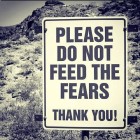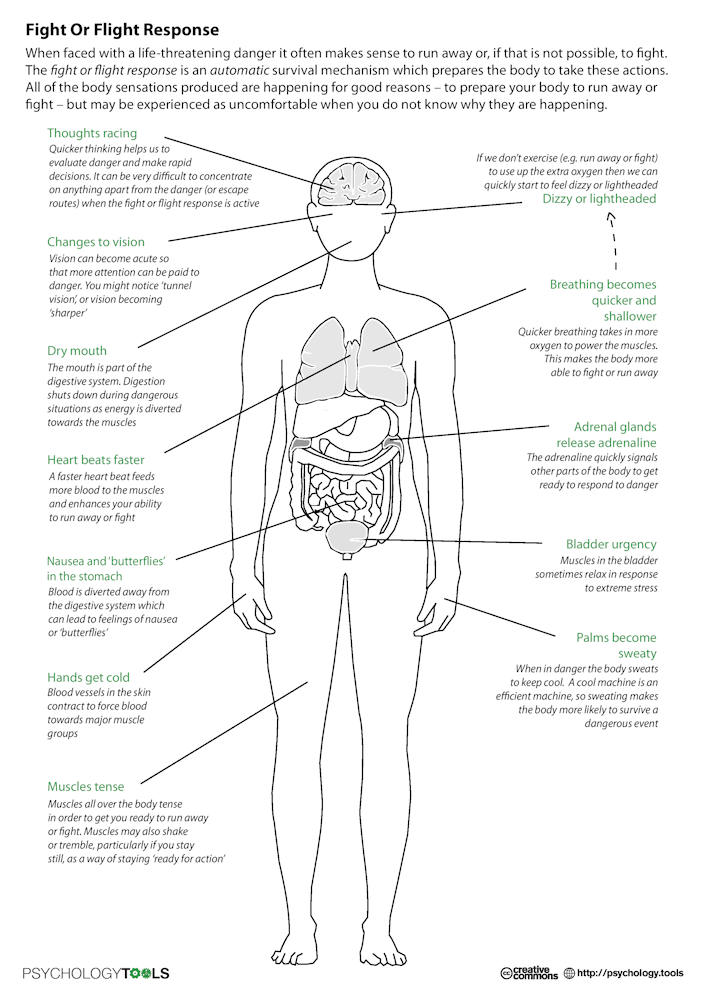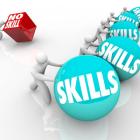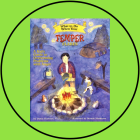Tag Archives:relaxation
Panic Attacks Part 2: The Antidote to Panic - Relaxation Breathing share
Previous article in this series:
- Panic Attacks Part 1: What is Panic & Why We Need It
Relaxation breathing is the antidote to panic. Literally. It is impossible to be truly breathing in a relaxed way and to be experiencing a full-blown panic attack at the same time. This is because relaxation breathing helps to reset our body chemistry to a “normal” state and bring it out of panic. If you haven’t read it yet, the previous article in this series, Panic Attacks Part 1: What is Panic & Why We Need It, you might want to check it out.
Some people may tell you that there is a “right way” to do relaxation breathing. In my opinion, if you try the “right way” and you find it to be really annoying and just plain won’t do it, then clearly that is not the right way for you. Generally, the recommendation is that you are breathing out for a longer count than you are breathing in and that you are taking in air by expanding your belly muscles, not your chest muscles.
My recommendation is that you find something that feels comfortable for you and go with that approach. No matter which approach you choose, the most important thing is that you practice relaxation breathing every day when you are already calm. I cannot stress this point enough. When your body is in panic mode, learning a new skill is not something that your brain is going to be very good at. So if you’re heading into a panic attack and you haven’t been practicing your relaxation breathing, don’t be surprised if it doesn’t work to help you return to calm…yet.
Regardless of the breathing technique that you decide to use, I recommend that you practice your relaxation breathing during a time that you are already relatively calm and relaxed, for five minutes at a time, a minimum of 1-2 times every day, with one of those times being at night when you are lying down to fall asleep. The main goal is to be able to clear your mind of all thought and just focus on the sensation of your breath going in and out of your body. Or, you can add some sort of positive phrase that you can repeat to yourself if it helps. (For example: “Breathe in calm. Breathe out fear,” but it could be anything so long as you interpret it as positive and relaxing.)
Below is a video that describes square breathing and then, below that, a few other informational links. The video is geared towards kids but you can use whatever imagery you like, and, who doesn’t enjoy the smell of fresh baked cookies?? (You’ll understand that last comment when you watch the video.)
Additional Breathing Information:
- Another take on square breathing, including a printable that you can download and customize.
- Diaphragmatic breathing, also known as “belly breathing,” which can be blended with square breathing if you’d like.
If you have a smart phone, there are also plenty of free apps that you can download to help coach you through relaxation breathing. Here are two that I’ve had experience with:
- Breathe2Relax – availabe on iPhone and Android (I recommend adjusting the default settings to what is comfortable for you.)
- Centered – available on iPhone only 🙁
Remaining articles in this series:
- Panic Attacks Part 3: Fear of the Fear – Don’t Let Panic Attacks Take Over Your Life
- Panic Attacks Part 4: Time To Tune Into Your Early Warning System (coming soon)
Panic Attacks Part 3: Fear of the Fear - Don't Let Panic Attacks Take Over Your Life share
Previous articles in this series:
- Panic Attacks Part 1: What is Panic & Why We Need It
- Panic Attacks Part 2: The Antidote for Panic & Relaxation Breathing
Panic attacks feel very intense when you have them. At best, it’s not a comfortable feeling. At worst, it feels very scary because your body feels like it’s out of control. Some people even worry that they are having a heart attack. If you are experiencing these symptoms for the first time, definitely talk with a medical professional to rule out any medical causes before treating the symptoms as a panic attack. This is important for two reasons. The first is that you need to get a proper diagnosis. The second is that if you are constantly worrying that you are having a heart attack…that’s going to increase your anxiety and make successfully treating panic very difficult.
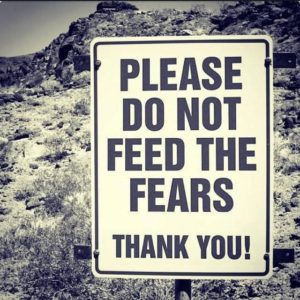 Once you know that your body is healthy and ok, it’s time to dig in to the emotional aspects that come into play with panic and anxiety. When you worry too much about the possibility that you might have a panic attack, then this worry itself can become the trigger for your next panic attack. I call this having “fear of the fear (that it will happen again).” With the use of acceptance, information, “growth mindset,” and skill development, here are some guidelines that work against the negative spiral that can happen when people start to develop a “fear of the fear.” This article assumes that you already have started working on developing the skills for turning around a panic attack and is part 3 of a four-part series of articles I hope to complete. Hopefully, I’ll get part 4 up soon!
Once you know that your body is healthy and ok, it’s time to dig in to the emotional aspects that come into play with panic and anxiety. When you worry too much about the possibility that you might have a panic attack, then this worry itself can become the trigger for your next panic attack. I call this having “fear of the fear (that it will happen again).” With the use of acceptance, information, “growth mindset,” and skill development, here are some guidelines that work against the negative spiral that can happen when people start to develop a “fear of the fear.” This article assumes that you already have started working on developing the skills for turning around a panic attack and is part 3 of a four-part series of articles I hope to complete. Hopefully, I’ll get part 4 up soon!
- Recognize that this is a new situation for you and, because of that, it makes sense that it’s hard in the beginning to figure out what’s happening and how best to manage it. Also, know that you’re not alone. There are many people who have or are currently going through this too.You are having, what is called, a panic attack. [Growth Mindset]
- Remember that fight or flight mode is a normal thing that our bodies do. The only problem is that it’s getting triggered when you don’t actually need to respond physically to an emotionally stressful situation. The most important thing to know here is, NO HARM WILL COME TO YOUR BODY AS YOU EXPERIENCE IT (your body physically revving up to fight or flee). It does feel yucky to be in physical panic mode. This is especially true because your body, in that moment, is primed with an abundance of energy to physically react and that means that you experience temporary physical changes to your body (i.e. increased heart rate, quick & shallow breathing, increased blood circulation to muscles, decreased blood circulation to the “rational” part of your brain, and more), but your body naturally knows how to shift out of this mode when the perception of a physical threat is gone. [Watch this great video about how the US government has learned to train Navy SEALS not to panic.]
- Accept that this is not your last panic attack. What I’m saying here is find a way to be ok with knowing that it will happen again AND that should one happen and your growing relaxation and cognitive skills can’t turn it around, you can ride it out until it’s done and be still be ok. In general, the goal is for the panic attacks to start reducing in intensity as you get better at turning them around but this won’t happen if you avoid panic attacks, or things that might cause them, rather than face them. [Acceptance]
- Continue to experiment with and practice various relaxation techniques (relaxation breathing is the most important one for panic) and good self care habits so that you can hone your skills and have more “tools” in your “toolbox” when the need arises. [Skill Development]
- Work on developing cognitive strategies that can help prevent panic attacks from happening or intervene at the early signs of panic so that you can prevent a full blown physical response. [Skill Development]
- Keep a list of things that help turn your panic attacks around so that you can refer to the list the next time. [Skill Development]
- Remembering that low blood sugar, hypoglycemia, can mimic the beginning feelings of a panic attack, carry a healthy snack with you that has a nice combination of protein and complex carbs. [Check out this podcast by Dr. Kristen Allot about why this is so incredibly important.]
- Minimize or, ideally, eliminate caffeine. Drink water. Enjoy water. Did I mention water? [Information]
Remaining article in this series:
- Panic Attacks Part 4: Time To Tune Into Your Early Warning System (coming soon)
Panic & Time Magazine's "How to Increase Mental Toughness: 4 Secrets From Navy SEALs and Olympians" by Eric Barker share
Panic. Our body’s ability to prime itself for a life-saving level of physical response, “fight or flight,” is a gift. It allows us to summon every possible physical resource we have to save ourselves from a physical threat. But, when the threat is imagined or emotional, it feels really yucky to be in physical panic mode. This is especially true because our bodies, in that moment, experience temporary physical changes (i.e. increased heart rate, quick & shallow breathing, increased blood circulation to muscles, decreased blood circulation to the “rational” part of your brain, etc. Click image on the right for more details.) that can feel scary if we don’t understand why it’s happening. However, our body naturally knows how to shift out of this mode when the perception of the threat is gone. Of course, because being in that high alert mode has our body burning off a great deal of our energy in a short amount of time, we’re left feeling exhausted in the aftermath, even if we didn’t actually fight or flee.
(If you can’t see the embedded video at the top of this page, click on the following link for the article and scroll down to the second video on the page that’s titled, “Navy SEALs Mental Training.”) The video displayed at the top of this page and accompanying article explains our body’s normal fight, flight, or freeze response and ways that the Navy SEALs and Olympic athletes train to have as much control as possible over preventing their bodies from triggering this response when they don’t want it.
Emphasis is on understanding the biology behind what is happening in our bodies when we experience fear and then using four basic skills to help our minds not be unnecessarily controlled by fear and panic:
- Positive Self-Talk
- Goal Setting
- Practice Visualization
- Use Simulations (practice)
All of these techniques are key components to CBT (Cognitive and Behavioral Therapy) and are used in therapy sessions with clients every day to treat both excessive anxiety as well as depression. And, if you struggle with “panic attacks”, the fight, flight, or freeze response is technically what is happening in your body (this involves the amygdala, hypothalamus, and adrenaline). It is a normal body function that is being triggered when there is the perception of a threat and prepares us to cope with life threatening situations. However, when it comes to fear, our minds don’t differentiate between physical threats and mental/emotional threats. But, the reality is that that the fight, flight, or freeze response isn’t very helpful when it comes to dealing with mental/emotional threats. So, the better we can use coping skills to prevent ourselves from the panicking, the more success we will have in coping with the challenges we face.
The video also mentions using relaxation breathing as the primary method of quickly recovering from when our fight, flight, or freeze response has been triggered. It talks about how particularly long exhales mimic our body’s normal relaxation mode (which is a new idea for me, I’ll have to find the time to look into the research on that point) and that the increase in oxygen in the bloodstream helps get the more logical, frontal cortex of the brain re-engaged so that you can think through your situation more rationally.
So, the next time you happen to be working on improving your CBT skills, just remember that if it works for the intense challenges that Navy SEALs and Olympic athletes face during actual physical threats, with practice, it will work for you when you’re working on not freaking out about having to do something in every day life like public speaking or taking a trip to the grocery store.
Emotionally Intelligent Life Skills share
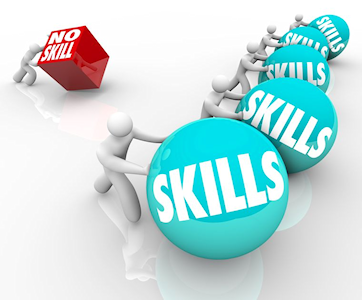 There are several types of skills that are worth working on because, as we all get better at them, they help us have less conflict and difficulty in our lives and increase the possibility that other people understand our thoughts and feelings. And the more often that happens, the more likely we are to experience our day to day life as happy. For example, Executive Functioning Skills help us to be organized so that we take care of the things we need to and help us to feel more responsible and in control of our lives. Mindfulness Skills help us to find pleasures in the small moments in life that are happening around us all of the time. They help us worry less and be happy more. Relaxation Skills, mindfulness being one of them, help us to calm anger and reduce panic and worry. Social Skills help us to work well in groups, create/deepen/maintain friendships and loving relationships, and increase the chances of other people having good/comfortable thoughts about us. Anger Management and Conflict Resolution Skills help us to not let our emotions create bigger problems for us than we already have and help us to solve problems in ways that encourage people to have good/comfortable thoughts about us.
There are several types of skills that are worth working on because, as we all get better at them, they help us have less conflict and difficulty in our lives and increase the possibility that other people understand our thoughts and feelings. And the more often that happens, the more likely we are to experience our day to day life as happy. For example, Executive Functioning Skills help us to be organized so that we take care of the things we need to and help us to feel more responsible and in control of our lives. Mindfulness Skills help us to find pleasures in the small moments in life that are happening around us all of the time. They help us worry less and be happy more. Relaxation Skills, mindfulness being one of them, help us to calm anger and reduce panic and worry. Social Skills help us to work well in groups, create/deepen/maintain friendships and loving relationships, and increase the chances of other people having good/comfortable thoughts about us. Anger Management and Conflict Resolution Skills help us to not let our emotions create bigger problems for us than we already have and help us to solve problems in ways that encourage people to have good/comfortable thoughts about us.
These are all skills that we start to learn as kids but that we continue to hone as adults. And, just like working out makes your muscles strong and makes it easier to do physical things , the more we practice these valuable life skills the stronger our life skills become and the easier it is to positively manage emotional things. Study after study shows that creating habits by practicing something over and over again reinforces neural pathways in our brains and results in “habits.” This means that the more we practice and flex our emotional muscles, the easier these skills become for us. So get out there and learn some new skills or just keep practicing the ones that you have already learned about. It pays off!!
What to Do When Your TEMPER FLARES by Dawn Huebner, PhD share
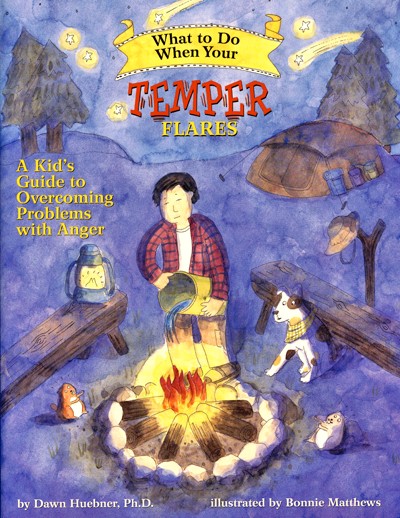 This is a fabulous workbook for kids. The book suggests using it from ages 6-12 but I think that is a loose guide and depends on the mindset of the child as well as their ability to understand that other people’s thoughts can be different than their own. Using fire as a metaphor for anger, the words and pictures then walk the reader through several different skills and approaches that can help a person develop a “longer fuse.” Explanations are concrete, using visual metaphors and practice to help increase skills that are very effective in managing anger. The author teaches, among other things, how our inner thoughts can affect our feelings and that if we work to adjust our thinking and give situations more of the benefit of the doubt,
This is a fabulous workbook for kids. The book suggests using it from ages 6-12 but I think that is a loose guide and depends on the mindset of the child as well as their ability to understand that other people’s thoughts can be different than their own. Using fire as a metaphor for anger, the words and pictures then walk the reader through several different skills and approaches that can help a person develop a “longer fuse.” Explanations are concrete, using visual metaphors and practice to help increase skills that are very effective in managing anger. The author teaches, among other things, how our inner thoughts can affect our feelings and that if we work to adjust our thinking and give situations more of the benefit of the doubt,
I use this book in session with some of my clients. Parents can also use this on their own with their kids and there is an introduction in the beginning of the book to help guide parents through how to approach it. With a positive, supportive approach you can really deepen your relationship with your child by being a resource that can help him or her to work through these challenges.
* I don’t make any money from the books that I recommend. My reviews are solely based on wanting to let people know what’s out there and could be helpful to them.


